Can Carbon Emission Trading Policy Reduce PM2.5? Evidence from Hubei, China
Abstract
:1. Introduction
2. Literature Review
2.1. Relevant Research on Haze Pollution Control
2.2. Research on Carbon Emission Trading
3. Institutional Background
4. Data and Methods
4.1. Synthetic Control Method
4.2. Variables and Data Sources
5. Analysis of Empirical Results
5.1. Estimate Results of SCM
5.2. Placebo Test
5.3. Permutation Test
6. Further Discussion
7. Conclusions
Author Contributions
Funding
Institutional Review Board Statement
Informed Consent Statement
Data Availability Statement
Acknowledgments
Conflicts of Interest
References
- Song, Z.; Storesletten, K.; Zilibotti, F. Growing Like China. Am. Econ. Rev. 2011, 101, 196–233. [Google Scholar] [CrossRef]
- Guo, S.; Hu, M.; Zamora, M.L.; Peng, J.; Shang, D.; Zheng, J.; Zhang, R. Elucidating severe urban haze formation in China. Proc. Natl. Acad. Sci. USA 2014, 111, 17373–17378. [Google Scholar] [CrossRef] [PubMed]
- Huang, R.J.; Zhang, Y.; Bozzetti, C.; Ho, K.F.; Cao, J.J.; Han, Y.; Prévôt, A.S. High secondary aerosol contribution to particulate pollution during haze events in China. Nature 2014, 514, 218–222. [Google Scholar] [CrossRef] [PubMed]
- Valavanidis, A.; Fiotakis, K.; Vlachogianni, T. Airborne Particulate Matter and Human Health: Toxicological Assessment and Importance of Size and Composition of Particles for Oxidative Damage and Carcinogenic Mechanisms. J. Environ. Sci. Health Part C 2008, 26, 339–362. [Google Scholar] [CrossRef]
- Schlesinger, R.B.; Kunzli, N.; Hidy, G.M.; Gotschi, T.; Jerrett, M. The Health Relevance of Ambient Particulate Matter Characteristics: Coherence of Toxicological and Epidemiological Inferences. Inhal. Toxicol. 2006, 18, 95–125. [Google Scholar] [CrossRef]
- Hall, J.V.; Brajer, V.; Lurmann, F.W. Air pollution, health and economic benefits—Lessons from 20years of analysis. Ecol. Econ. 2010, 69, 2590–2597. [Google Scholar] [CrossRef]
- Lelieveld, J.; Evans, J.S.; Fnais, M.; Giannadaki, D.; Pozzer, A. The contribution of outdoor air pollution sources to premature mortality on a global scale. Nature 2015, 525, 367–371. [Google Scholar] [CrossRef]
- Gao, M.; Guttikunda, S.K.; Carmichael, G.R.; Wang, Y.; Liu, Z.; Stanier, C.O.; Yu, M. Health impacts and economic losses assessment of the 2013 severe haze event in Beijing area. Sci. Total Environ. 2015, 511, 553–561. [Google Scholar] [CrossRef]
- Zheng, Y.; Zhang, Q.; Tong, D.; Davis, S.J.; Caldeira, K. Climate effects of China’s efforts to improve its air quality. Environ. Res. Lett 2020, 15, 104052. [Google Scholar] [CrossRef]
- Ramanathan, V.; Crutzen, P.J.; Kiehl, J.T.; Rosenfeld, D. Aerosols, Climate, and the Hydrological Cycle. Science 2001, 294, 2119–2124. [Google Scholar] [CrossRef] [Green Version]
- Shao, T.; Liu, Y.; Wang, R.; Zhu, Q.; Tan, Z.; Luo, R. Role of anthropogenic aerosols in affecting different-grade precipitation over eastern China: A case study. Sci. Total Environ. 2022, 807, 150886. [Google Scholar] [CrossRef] [PubMed]
- Liu, X. The influence of urban haze pollution on urban shrinkage in China—An analysis of the mediating effect of the labor supply. Environ. Sci. Pollut. Res. 2021, 28, 63297–63304. [Google Scholar] [CrossRef] [PubMed]
- Zhou, A.; Li, J. Air pollution and income distribution: Evidence from Chinese provincial panel data. Environ. Sci. Pollut. Res. 2021, 28, 8392–8406. [Google Scholar] [CrossRef] [PubMed]
- Tang, H.; Liu, J.; Wu, J. The impact of command-and-control environmental regulation on enterprise total factor productivity: A quasi-natural experiment based on China’s “Two Control Zone” policy. J. Clean. Prod. 2020, 254, 120011. [Google Scholar] [CrossRef]
- Ren, S.; Li, X.; Yuan, B.; Li, D.; Chen, X. The effects of three types of environmental regulation on eco-efficiency: A cross-region analysis in China. J. Clean. Prod. 2018, 173, 245–255. [Google Scholar] [CrossRef]
- Jin, Y.; Andersson, H.; Zhang, S. Air Pollution Control Policies in China: A Retrospective and Prospects. Int. J. Environ. Res. Public Health 2016, 13, 1219. [Google Scholar] [CrossRef]
- Li, X.; Hu, Z.; Cao, J. The impact of carbon market pilots on air pollution: Evidence from China. Environ. Sci. Pollut. Res. 2021, 28, 62274–62291. [Google Scholar] [CrossRef]
- Wu, H.; Li, Y.; Hao, Y.; Ren, S.; Zhang, P. Environmental decentralization, local government competition, and regional green development: Evidence from China. Sci. Total Environ. 2020, 708, 135085. [Google Scholar] [CrossRef]
- Li, B. Top-down place-based competition and award: Local government incentives for non-GDP improvement in China. J. Chin. Gov. 2018, 3, 397–418. [Google Scholar] [CrossRef]
- Vo, X.V.; Zaman, K. Relationship between energy demand, financial development, and carbon emissions in a panel of 101 countries: “go the extra mile” for sustainable development. Environ. Sci. Pollut. Res. 2020, 27, 23356–23363. [Google Scholar] [CrossRef]
- Zhang, K.; Xu, D.; Li, S.; Wu, T.; Cheng, J. Strategic interactions in environmental regulation enforcement: Evidence from Chinese cities. Environ. Sci. Pollut. Res. 2021, 28, 1992–2006. [Google Scholar] [CrossRef] [PubMed]
- Zhang, D.; Karplus, V.J.; Cassisa, C.; Zhang, X. Emissions trading in China: Progress and prospects. Energy Policy 2014, 75, 9–16. [Google Scholar] [CrossRef]
- Zhang, Y.; Li, S.; Luo, T.; Gao, J. The effect of emission trading policy on carbon emission reduction: Evidence from an integrated study of pilot regions in China. J. Clean. Prod. 2020, 265, 121843. [Google Scholar] [CrossRef]
- Ge, S.; Yu, X.; Zhou, D.; Sang, X. The Integrated Effect of Carbon Emissions Trading and Pollution Rights Trading for Power Enterprises—A Case Study of Chongqing. Sustainability 2019, 11, 3099. [Google Scholar] [CrossRef]
- Wang, Y.; Yao, L.; Wang, L.; Liu, Z.; Ji, D.; Tang, G.; Xin, J. Mechanism for the formation of the January 2013 heavy haze pollution episode over central and eastern China. Sci. China Earth Sci. 2014, 57, 14–25. [Google Scholar] [CrossRef]
- Yang, L.; Li, F.; Zhang, X. Chinese companies’ awareness and perceptions of the Emissions Trading Scheme (ETS): Evidence from a national survey in China. Energy Policy 2016, 98, 254–265. [Google Scholar] [CrossRef]
- Mackenzie, I.A.; Hanley, N.; Kornienko, T. The optimal initial allocation of pollution permits: A relative performance approach. Environ. Resour. Econ. 2008, 39, 265–282. [Google Scholar] [CrossRef]
- Gibson, M. Regulation-Induced Pollution Substitution. Rev. Econ. Stat. 2019, 101, 827–840. [Google Scholar] [CrossRef]
- Hahn, R.W.; Malès, E.H. Can Regulatory Institutions Cope with Cross Media Pollution? J. Air Waste Manag. Assoc. 1990, 40, 24–31. [Google Scholar] [CrossRef]
- Bi, X. “Cleansing the air at the expense of waterways?” Empirical evidence from the toxic releases of coal-fired power plants in the United States. J. Regul. Econ. 2017, 51, 18–40. [Google Scholar] [CrossRef]
- Abadie, A.; Gardeazabal, J. The Economic Costs of Conflict: A Case Study of the Basque Country. Am. Econ. Rev. 2003, 93, 113–132. [Google Scholar] [CrossRef]
- Athey, S.; Imbens, G.W. The State of Applied Econometrics: Causality and Policy Evaluation. J. Econ. Perspect. 2017, 31, 3–32. [Google Scholar] [CrossRef]
- Guo, X.; Fu, L.; Sun, X. Can Environmental Regulations Promote Greenhouse Gas Abatement in OECD Countries? Command-and-Control vs. Market-Based Policies. Sustainability 2021, 13, 6913. [Google Scholar] [CrossRef]
- Xie, L.; Li, Z.; Ye, X.; Jiang, Y. Environmental regulation and energy investment structure: Empirical evidence from China’s power industry. Technol. Forecast. Soc. Chang. 2021, 167, 120690. [Google Scholar] [CrossRef]
- Bergquist, A.-K.; Söderholm, K.; Kinneryd, H.; Lindmark, M.; Söderholm, P. Command-and-control revisited: Environmental compliance and technological change in Swedish industry 1970–1990. Ecol. Econ. 2013, 85, 6–19. [Google Scholar] [CrossRef]
- Gerigk, J.; MacKenzie, I.A.; Ohndorf, M. A Model of Benchmarking Regulation: Revisiting the Efficiency of Environmental Standards. Environ. Resour. Econ. 2015, 62, 59–82. [Google Scholar] [CrossRef]
- Aidt, T.S.; Dutta, J. Transitional politics: Emerging incentive-based instruments in environmental regulation. J. Environ. Econ. Manag. 2004, 47, 458–479. [Google Scholar] [CrossRef]
- Li, W.; Gu, Y.; Liu, F.; Li, C. The effect of command-and-control regulation on environmental technological innovation in China: A spatial econometric approach. Environ. Sci. Pollut. Res. 2019, 26, 34789–34800. [Google Scholar] [CrossRef]
- Li, B.; Wu, S. Effects of local and civil environmental regulation on green total factor productivity in China: A spatial Durbin econometric analysis. J. Clean. Prod. 2017, 153, 342–353. [Google Scholar] [CrossRef]
- Cai, D.; Li, J. Pollution for Sale: Firms’ Characteristics and Lobbying Outcome. Environ. Resour. Econ. 2020, 77, 539–564. [Google Scholar] [CrossRef]
- Sjöberg, E. An empirical study of federal law versus local environmental enforcement. J. Environ. Econ. Manag. 2016, 76, 14–31. [Google Scholar] [CrossRef]
- Becker, R.; Henderson, V. Effects of Air Quality Regulations on Polluting Industries. J. Political Econ. 2000, 108, 379–421. [Google Scholar] [CrossRef]
- Coase, R.H. The Problem of Social Cost. J. Law Econ. 2013, 56, 837–877. [Google Scholar] [CrossRef]
- Liu, L.; Chen, C.; Zhao, Y.; Zhao, E. China׳s carbon-emissions trading: Overview, challenges and future. Renew. Sustain. Energy Rev. 2015, 49, 254–266. [Google Scholar] [CrossRef]
- Zhao, X.; Wu, L.; Li, A. Research on the efficiency of carbon trading market in China. Renew. Sustain. Energy Rev. 2017, 79, 1–8. [Google Scholar] [CrossRef]
- Jiang, W.; Liu, J.; Liu, X. Impact of Carbon Quota Allocation Mechanism on Emissions Trading: An Agent-Based Simulation. Sustainability 2016, 8, 826. [Google Scholar] [CrossRef]
- Liu, Y. Residents’ Willingness and Influencing Factors on Action Personal Carbon Trading: A Case Study of Metropolitan Areas in Tianjin, China. Sustainability 2019, 11, 369. [Google Scholar] [CrossRef]
- Zhu, Q.; Duan, K.; Wu, J.; Wang, Z. Agent-Based Modeling of Global Carbon Trading and Its Policy Implications for China in the Post-Kyoto Era. Emerg. Mark. Financ. Trade 2016, 52, 1348–1360. [Google Scholar] [CrossRef]
- Fang, G.; Tian, L.; Liu, M.; Fu, M.; Sun, M. How to optimize the development of carbon trading in China—Enlightenment from evolution rules of the EU carbon price. Appl. Energy 2018, 211, 1039–1049. [Google Scholar] [CrossRef]
- Feng, Y. Does China’s carbon emission trading policy alleviate urban carbon emissions? IOP Conf. Ser. Earth Environ. Sci. 2020, 508, 012044. [Google Scholar] [CrossRef]
- Qian, H.; Zhou, Y.; Wu, L. Evaluating various choices of sector coverage in China’s national emissions trading system (ETS). Clim. Policy 2018, 18, 7–26. [Google Scholar] [CrossRef]
- Wang, P.; Dai, H.; Ren, S.; Zhao, D.; Masui, T. Achieving Copenhagen target through carbon emission trading: Economic impacts assessment in Guangdong Province of China. Energy 2015, 79, 212–227. [Google Scholar] [CrossRef]
- Meyer, B.D. Natural and Quasi-Experiments in Economics. J. Bus. Econ. Stat. 1995, 13, 151–161. [Google Scholar]
- Aichele, R.; Felbermayr, G. The Effect of the Kyoto Protocol on Carbon Emissions: Kyoto and Carbon Emissions. J. Pol. Anal. Manag. 2013, 32, 731–757. [Google Scholar] [CrossRef]
- Haites, E. Carbon taxes and greenhouse gas emissions trading systems: What have we learned? Clim. Policy 2018, 18, 955–966. [Google Scholar] [CrossRef]
- Borghesi, S.; Cainelli, G.; Mazzanti, M. Linking emission trading to environmental innovation: Evidence from the Italian manufacturing industry. Res. Policy 2015, 44, 669–683. [Google Scholar] [CrossRef]
- Zhang, C.; Wang, Q.; Shi, D.; Li, P.; Cai, W. Scenario-based potential effects of carbon trading in China: An integrated approach. Appl. Energy 2016, 182, 177–190. [Google Scholar] [CrossRef]
- Caron, J.; Rausch, S.; Winchester, N. Leakage from sub-national climate policy: The case of California’s cap and trade program. Energy J. 2015, 36. [Google Scholar] [CrossRef]
- Goulder, L.H.; Morgenstern, R.D.; Munnings, C.; Schreifels, J. China’s national carbon dioxide emission trading system: An introduction. Econ. Energy Environ. Policy 2017, 6, 1–18. [Google Scholar] [CrossRef]
- Zeng, N.; Jiang, K.; Han, P.; Hausfather, Z.; Cao, J.; Kirk-Davidoff, D.; Ali, S.; Zhou, S. The Chinese Carbon-Neutral Goal: Challenges and Prospects. Adv. Atmos. Sci 2022, 39, 1229–1238. [Google Scholar] [CrossRef]
- Li, H.; Lei, M. The influencing factors of China carbon price: A study based on carbon trading market in hubei province. IOP Conf. Ser. Earth Environ. Sci. 2018, 121, 052073. [Google Scholar] [CrossRef]
- Dawid, A.P. Causal Inference without Counterfactuals. J. Am. Stat. Assoc. 2000, 95, 407–424. [Google Scholar] [CrossRef]
- Abadie, A.; Diamond, A.; Hainmueller, J. Synthetic Control Methods for Comparative Case Studies: Estimating the Effect of California’s Tobacco Control Program. J. Am. Stat. Assoc. 2010, 105, 493–505. [Google Scholar] [CrossRef]
- Van, D.A.; Martin, R.V.; Brauer, M.; Boys, B.L. Use of Satellite Observations for Long-Term Exposure Assessment of Global Concentrations of Fine Particulate Matter. Environ. Health Perspect. 2015, 123, 135–143. [Google Scholar]
- Leng, X.; Zhong, S.; Kang, Y. Citizen participation and urban air pollution abatement: Evidence from environmental whistle-blowing platform policy in Sichuan China. Sci. Total Environ. 2022, 816, 151521. [Google Scholar] [CrossRef] [PubMed]
- Guo, Y.; Zhang, Q.; Lai, K.K.; Zhang, Y.; Wang, S.; Zhang, W. The Impact of Urban Transportation Infrastructure on Air Quality. Sustainability 2020, 12, 5626. [Google Scholar] [CrossRef]
- Borck, R.; Schrauth, P. Population density and urban air quality. Reg. Sci. Urban Econ. 2021, 86, 103596. [Google Scholar] [CrossRef]
- Kim, S.-Y.; Kim, H.; Lee, J.-T. Health Effects of Air-Quality Regulations in Seoul Metropolitan Area: Applying Synthetic Control Method to Controlled-Interrupted Time-Series Analysis. Atmosphere 2020, 11, 868. [Google Scholar] [CrossRef]
- Xu, B.; Lin, B. Regional differences of pollution emissions in China: Contributing factors and mitigation strategies. J. Clean. Prod. 2016, 112, 1454–1463. [Google Scholar] [CrossRef]
- Colvile, R.N.; Hutchinson, E.J.; Mindell, J.S.; Warren, R.F. The transport sector as a source of air pollution. Atmos. Environ. 2001, 35, 1537–1565. [Google Scholar] [CrossRef]
- Xia, Q.; Li, L.; Dong, J.; Zhang, B. Reduction Effect and Mechanism Analysis of Carbon Trading Policy on Carbon Emissions from Land Use. Sustainability 2021, 13, 9558. [Google Scholar] [CrossRef]
- Abadie, A.; Diamond, A.J.; Hainmueller, J. Comparative Politics and the Synthetic Control Method. Am. J. Political Sci. 2015, 59, 495–510. [Google Scholar] [CrossRef]
- Baron, R.M.; Kenny, D.A. The moderator–mediator variable distinction in social psychological research: Conceptual, strategic, and statistical considerations. J. Personal. Soc. Psychol. 1986, 51, 1173–1182. [Google Scholar] [CrossRef]
- Hayes, A.F. Beyond Baron and Kenny: Statistical Mediation Analysis in the New Millennium. Commun. Monogr. 2009, 76, 408–420. [Google Scholar] [CrossRef]
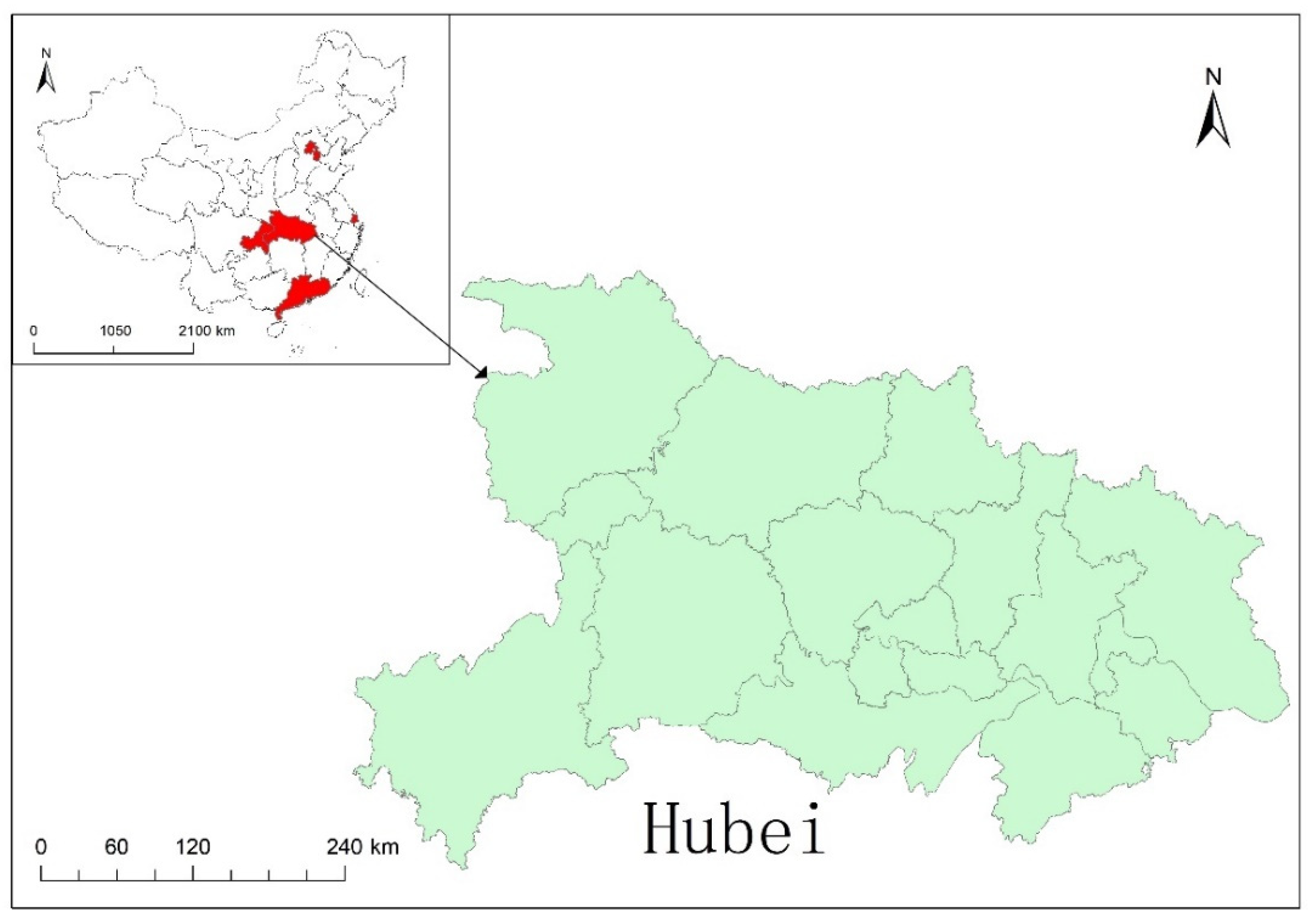
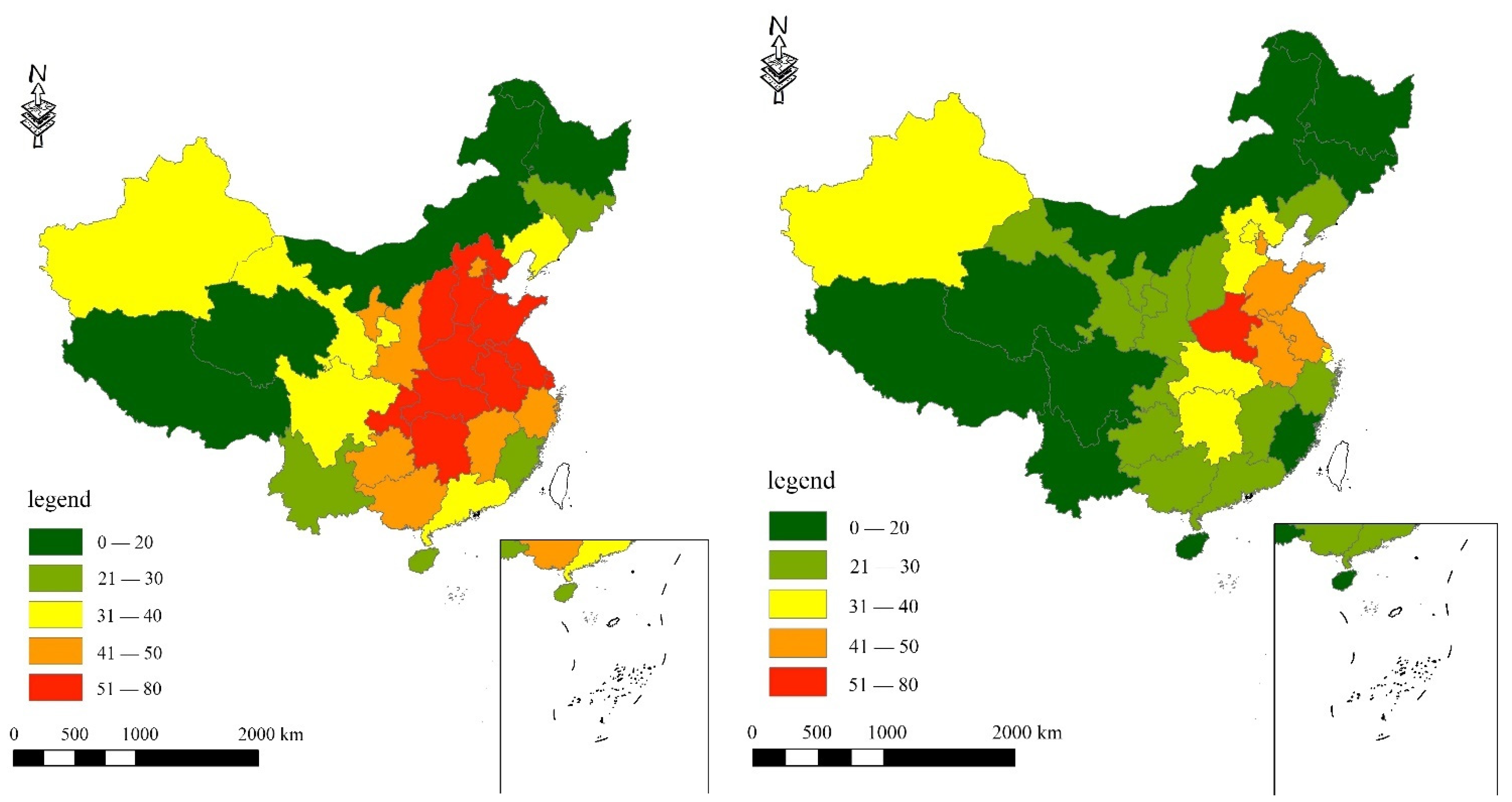
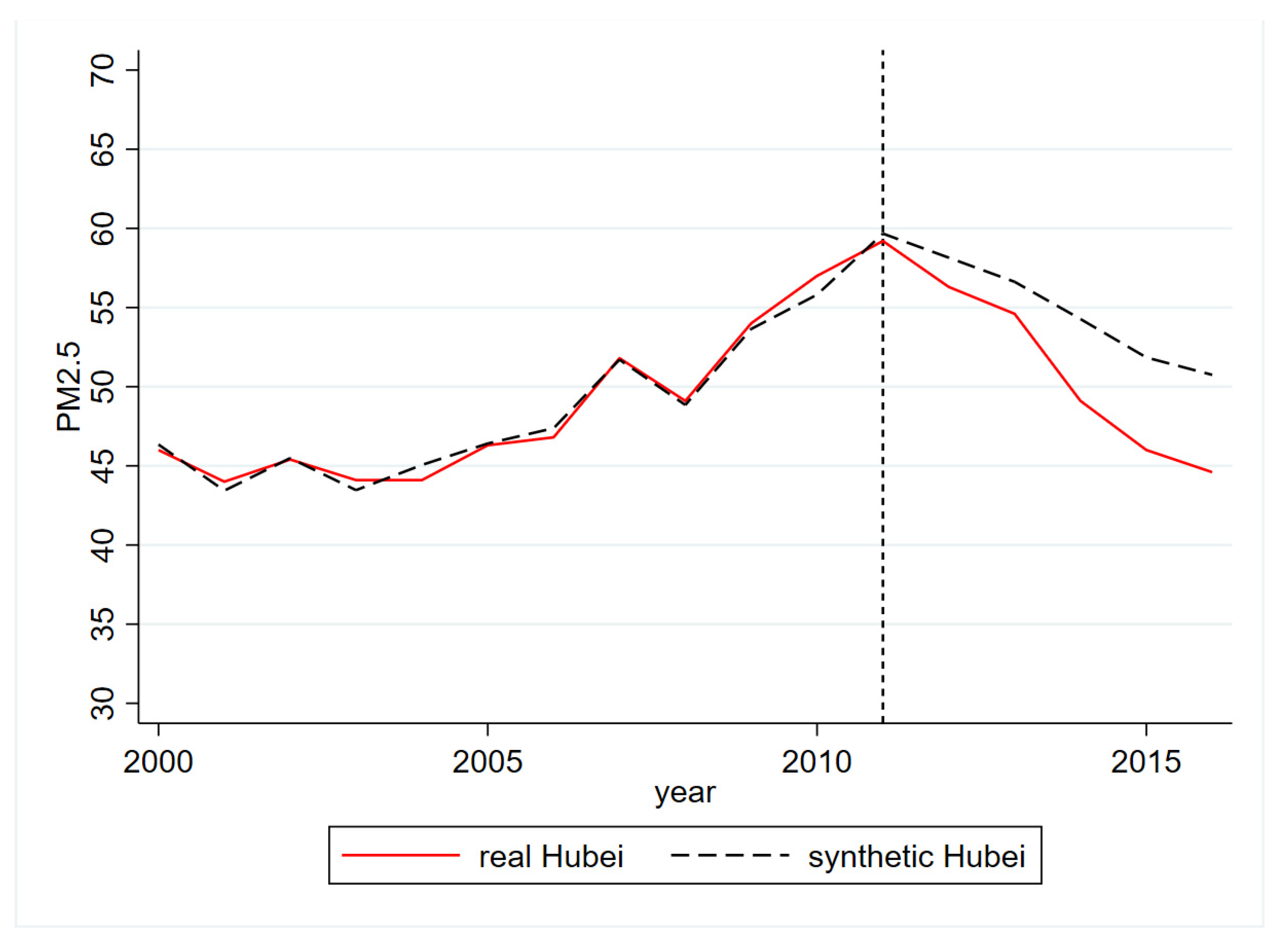
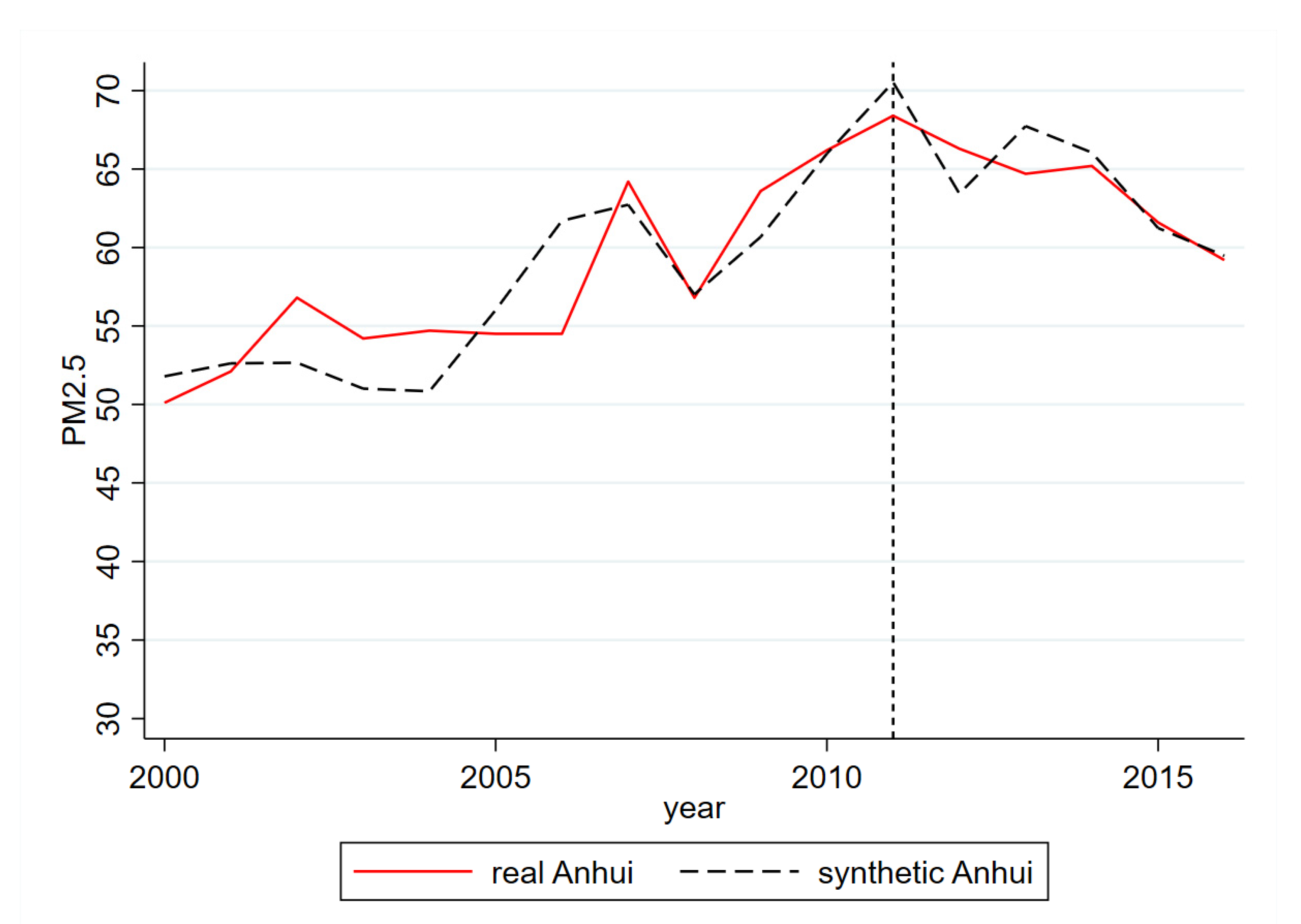
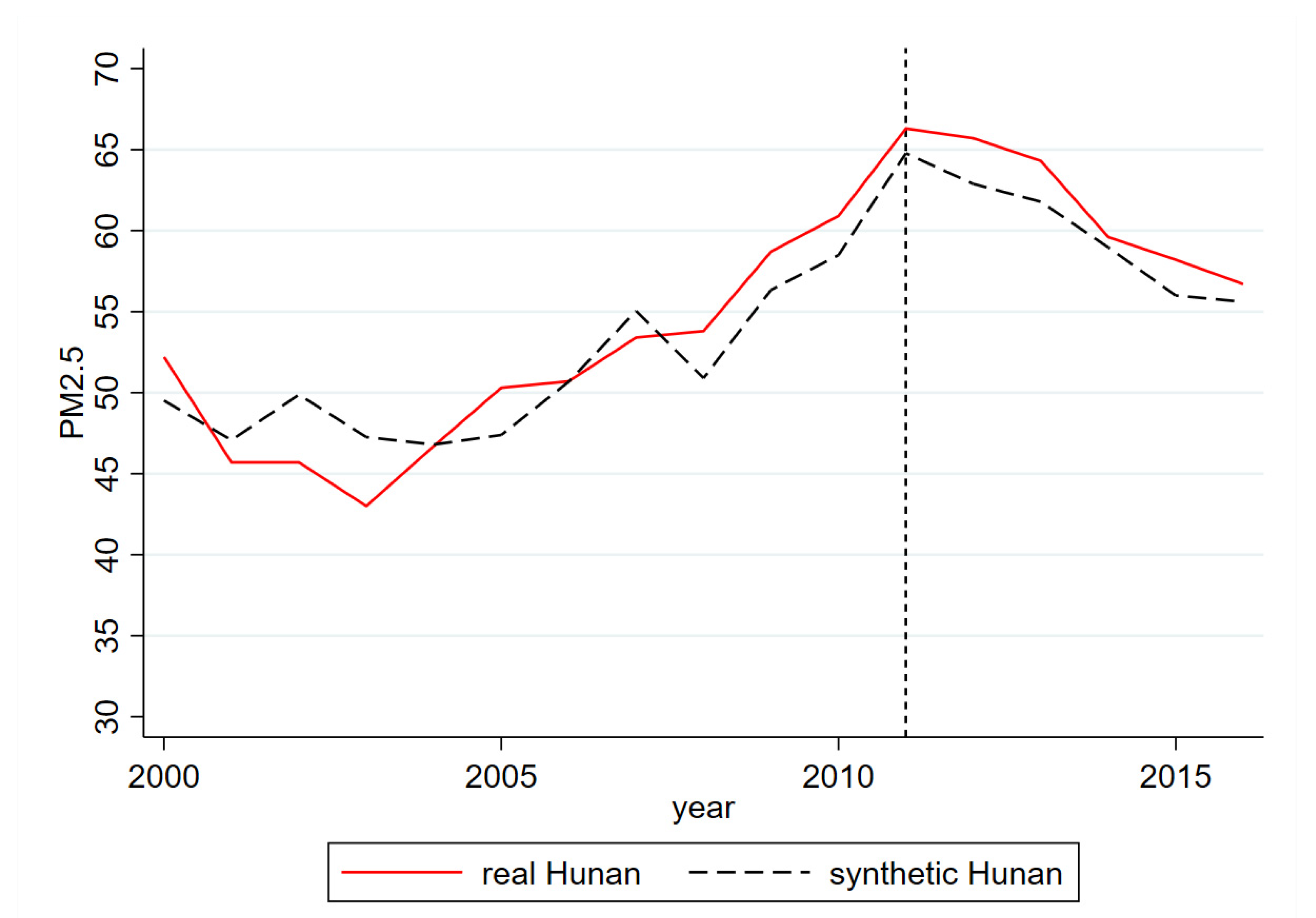
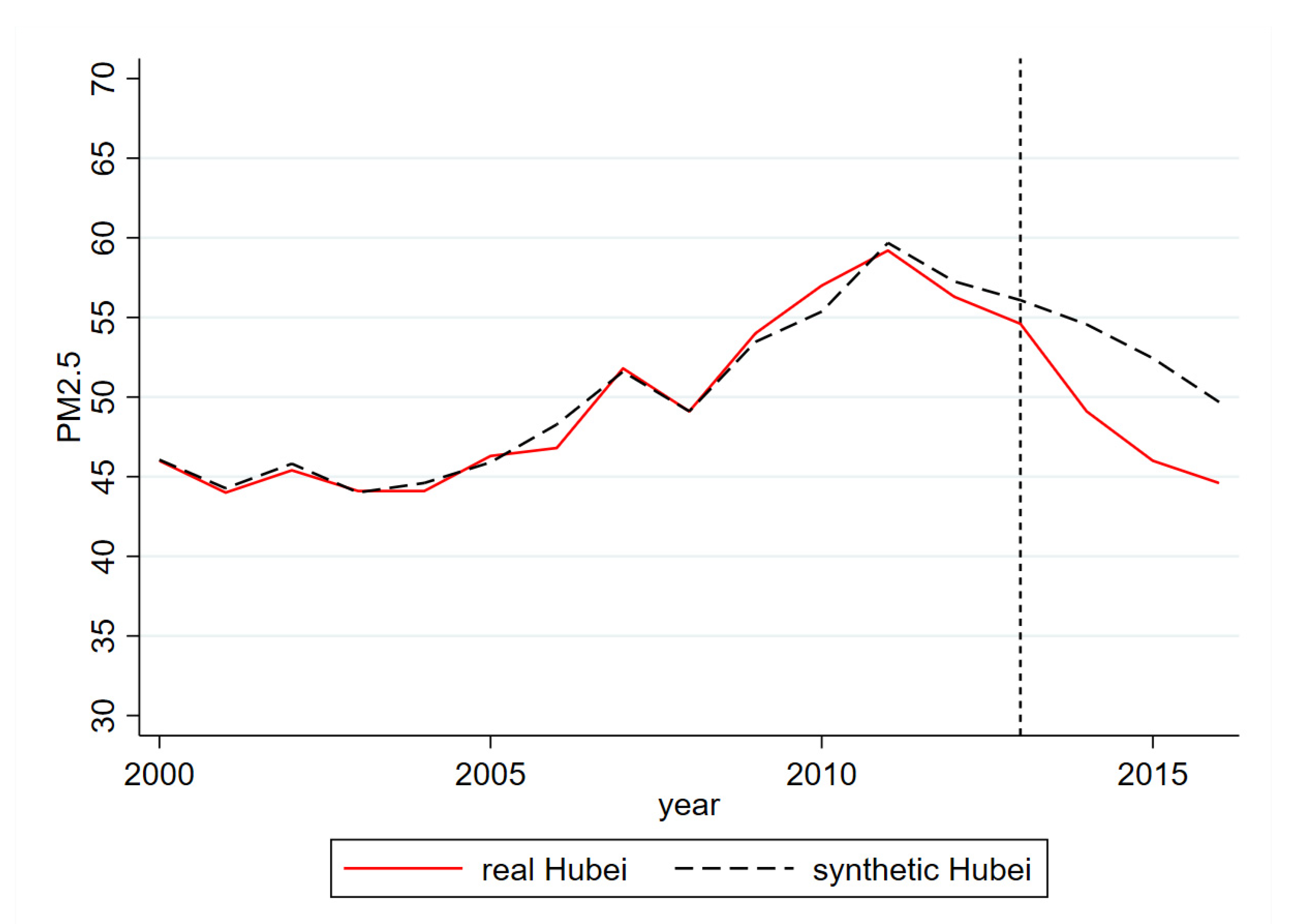
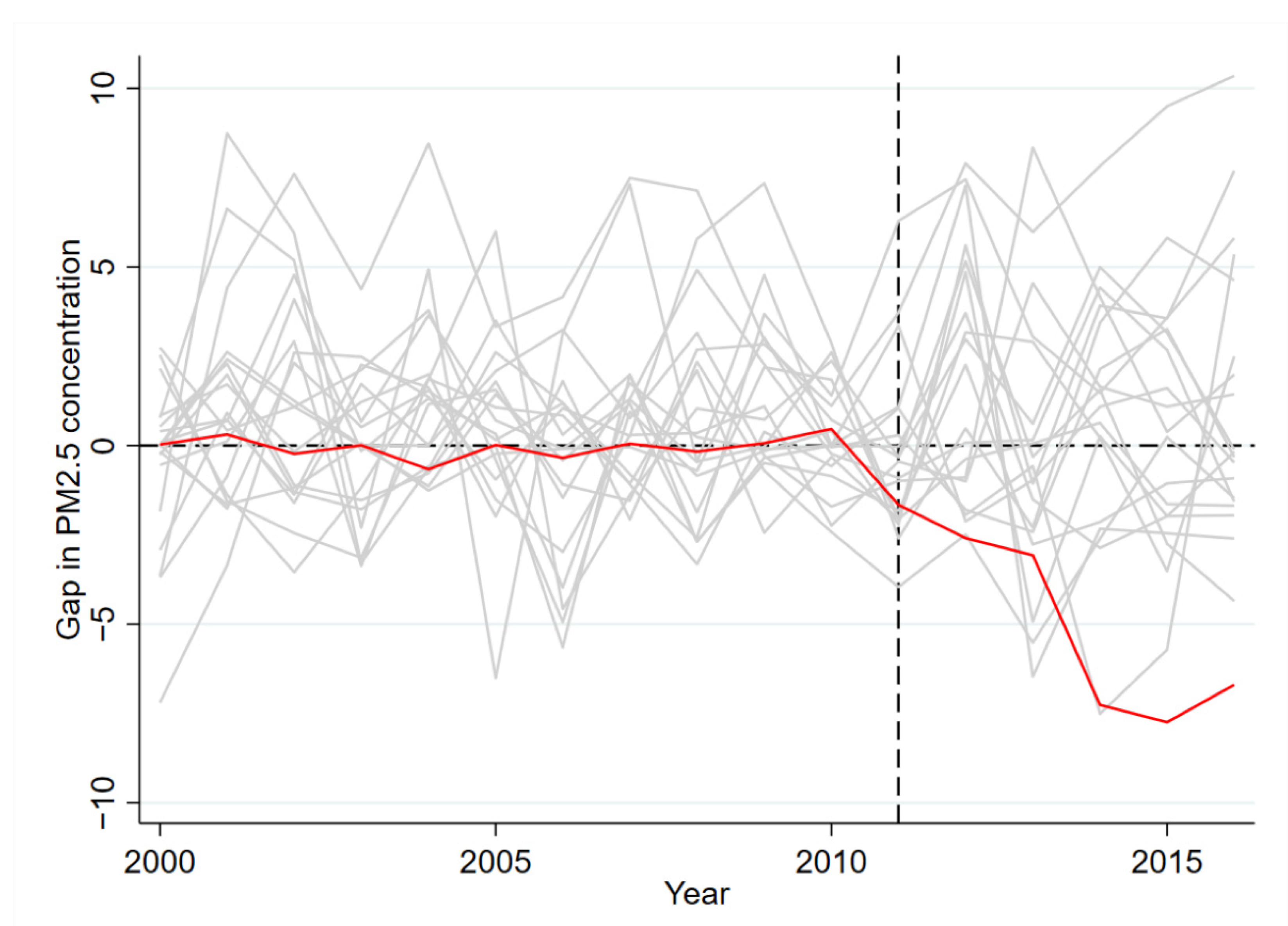
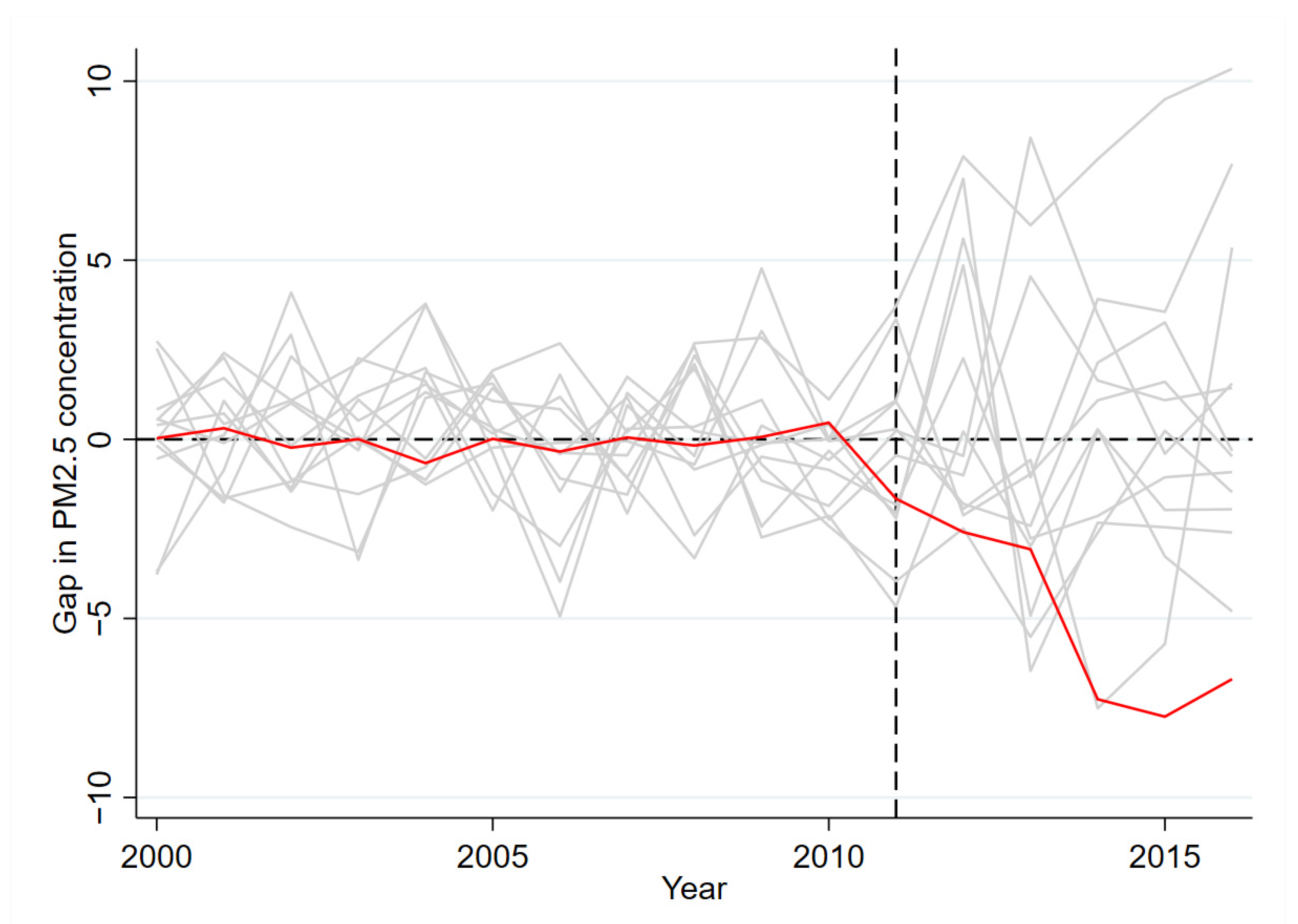
| Predictor | Index | Abbreviation |
|---|---|---|
| Economic size | GDP/Total population | ES |
| Population density | Population/Area | PD |
| Urbanization rate | Urban population/Total population | UR |
| Transport sector | Car ownership | TS |
| Energy consumption | Total of all energy consumption | EC |
| Provinces Involved in Synthesis | Hunan | Anhui | Liaoning | Fujian | Shanxi | Ningxia | Hainan |
|---|---|---|---|---|---|---|---|
| weight | 0.512 | 0.269 | 0.135 | 0.051 | 0.024 | 0.007 | 0.002 |
| Predictive Variables | Real Hubei | Synthetic Hubei | Average of Control Provinces |
|---|---|---|---|
| Economic size | 1,3661.91 | 1,3565.69 | 1,4941.83 |
| Population density | 292.90 | 292.83 | 254.47 |
| Energy consumption | 5478.58 | 5431.26 | 8006.99 |
| Transport sector | 56.97 | 63.17 | 71.89 |
| Urbanization rate | 0.3911 | 0.3908 | 0.3931 |
| Washington (2000) | 46.00 | 46.00 | 35.67 |
| Washington (2005) | 46.30 | 46.26 | 32.00 |
| Washington (2010) | 57.00 | 55.90 | 39.06 |
| Variable | Pit | EST | Pit | RD | Pit | Pit |
|---|---|---|---|---|---|---|
| (1) | (2) | (3) | (4) | (5) | (6) | |
| Time × treatit | −5.236 ** | −0.655 *** | −4.976 ** | 1277.094 *** | −6.2776 ** | −7.0340 *** |
| (−2.10) | (−5.63) | (−2.11) | (4.87) | (−2.10) | (−2.36) | |
| EST | −2.007 ** | −1.587 *** | ||||
| (−2.01) | (−3.38) | |||||
| RD | 0.0007 *** | 0.0009 *** | ||||
| (3.26) | (5.17) | |||||
| ES | 0.002 *** | 0.006 ** | −0.003 *** | 24.173 *** | −0.002 *** | −0.003 *** |
| (4.24) | (2.63) | (−4.22) | (3.72) | (−5.20) | (−4.63) | |
| PD | 0.016 *** | 0.038 | 0.157 *** | 125.302 | 0.016 *** | 0.024 *** |
| (4.49) | (0.06) | (4.48) | (0.34) | (4.58) | (4.27) | |
| TS | 0.005 | −0.052 *** | 0.005 | 7284.004 *** | 0.005 ** | 0.003 |
| (0.96) | (−5.56) | (0.97) | (13.38) | (2.05) | (1.21) | |
| UR | −0.009 ** | −0.492 | −0.973 ** | 3024.54 | −0.097 ** | −0.125 * |
| (−2.02) | (−0.50) | (−2.01) | (0.59) | (−2.19) | (−1.66) | |
| EI | 0.001 *** | 0.001 *** | 0.012 *** | 38.688 *** | 0.001 *** | 0.003 *** |
| (9.18) | (4.74) | (5.28) | (2.71) | (8.82) | (7.61) | |
| Time fixed effect | YES | YES | YES | YES | YES | YES |
| Regional fixed effect | YES | YES | YES | YES | YES | YES |
| Observed value | 422 | 422 | 422 | 422 | 422 | 422 |
| R2 | 0.6409 | 0.9121 | 0.5827 | 0.9794 | 0.6815 | 0.6022 |
Publisher’s Note: MDPI stays neutral with regard to jurisdictional claims in published maps and institutional affiliations. |
© 2022 by the authors. Licensee MDPI, Basel, Switzerland. This article is an open access article distributed under the terms and conditions of the Creative Commons Attribution (CC BY) license (https://creativecommons.org/licenses/by/4.0/).
Share and Cite
Wang, R.; Tang, H.; Ma, X. Can Carbon Emission Trading Policy Reduce PM2.5? Evidence from Hubei, China. Sustainability 2022, 14, 10755. https://doi.org/10.3390/su141710755
Wang R, Tang H, Ma X. Can Carbon Emission Trading Policy Reduce PM2.5? Evidence from Hubei, China. Sustainability. 2022; 14(17):10755. https://doi.org/10.3390/su141710755
Chicago/Turabian StyleWang, Ruiqi, Huanchen Tang, and Xin Ma. 2022. "Can Carbon Emission Trading Policy Reduce PM2.5? Evidence from Hubei, China" Sustainability 14, no. 17: 10755. https://doi.org/10.3390/su141710755
APA StyleWang, R., Tang, H., & Ma, X. (2022). Can Carbon Emission Trading Policy Reduce PM2.5? Evidence from Hubei, China. Sustainability, 14(17), 10755. https://doi.org/10.3390/su141710755





